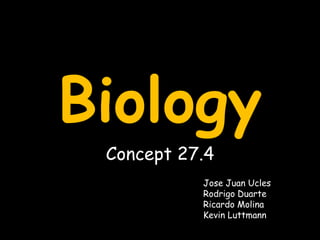
Concept 27.4
- 1. Biology Concept 27.4 Jose Juan Ucles Rodrigo Duarte Ricardo Molina Kevin Luttmann
- 2. The skeleton functions in support and movement Vocabulary Vertebra Cartilage Marrow Joint Ligament Arhtritis Osteorporosis
- 3. Definitions Vertebra: Segment of the backbone; encloses and protects the nerve cord. Cartilage: Type of connective tissue softer than bone. Marrow: Specialized tissue found in bone; yellow bone marrow consists of stored fat that serves as an energy reserve; red bone marrow makes cells that develop into blood cells. Joint: Area where one bone meets another. Ligament: Strong fibrous connective tissue that holds together the bones in movable joints. Arthritis: Group of skeletal disorders characterized by inflamed joints. Osteoporosis: Disorder in which bones become thinner, more porous, and more easily broken.
- 4. Anatomy of the Skeleton The skeleton provides a strong framework that holds your body up and maintains its shape. The skeleton also protects soft organs and provides attachment sites for your muscles. The human skeleton consists of 206 bones.
- 5. Bones as Living Organisms Your bones are organs made up of living connective tissue. Within this very dense connective tissue, a material known asbone matrix surrounds the bone cells. Bone matrix consists of flexible fibers of the protein collagen and a hard mineral made of calcium and phosphate. The collagen keeps the bone flexible and non-brittle, while the hard mineral helps the bone withstand forces that push on it. A sheet of fibrous connective tissue covers most of the outside surface of the bone . In addition to covering the ends of bones, cartilage is found in the tip of your nose and the outer portion of your ears. When you were a newborn, much of your skeleton was made up of cartilage. As you grew, this cartilage was gradually replaced by bone as minerals circulating in the blood accumulated in the developing bone. Bones continue to grow in length in women until about age 18, and in men until about age 21. Many bones contain specialized tissues called marrow. The shafts of long bones, such as the arm bone (humerus), have a central cavity containing yellow bone marrow. Yellow bone marrow consists of stored fat and serves as an energy reserve for the body.
- 6. How joints work An area where one bone meets another bone is called a joint. Some joints connect bones in a way that allows little or no movement. Such joints are called immovable joints. By being unable to move, these bones better protect the soft organs that lie beneath them. Yet, if all your bones were fused together in one continuous skeleton, you would not be able to move. Movable joints allow you to bend, twist, and rotate your limbs, neck, and torso. The bones in a movable joint are held together by a strong, fibrous connective tissue called a ligament. Movable joints can be classified by the way in which the bones come together. The different structures of the joints allow your body to move in a variety of ways.
- 7. Skeletal Disorders Since bones consist of living tissue, they can repair themselves by building new tissue. If properly set using a cast or splint, a bone will usually return to its normal shape and strength. Besides fractures, bones and joints can be affected by disorders of the skeletal system. Arthritis refers to a group of skeletal disorders that involve inflammation of the joints. One out of every three adults in the United States suffers from arthritis or a related joint disorder. Osteoporosis is a disorder in which bones become thinner, more porous, and more easily broken.
- 8. END
